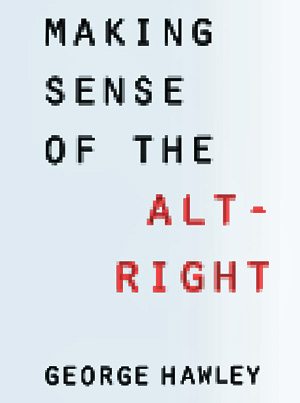
This book traces the antecedents, origins, major figures, and tactics of the white nationalist movement commonly known as the Alt-Right. Although the Alt-Right’s ideology is not new, it is much more effective at drawing attention and converts than its recent predecessors. We can primarily attribute the Alt-Right’s success to its skillful use of the internet, which it effectively used to inject itself into the national conversation. Breaking from earlier manifestations of white nationalism, the Alt-Right embraced an ironic, transgressive tone that appealed to many disaffected white millennials. The internet also allowed the movement to grow because it allows white nationalists to maintain anonymity; most of the people creating and consuming Alt-Right material remain anonymous, which keeps them generally safe from the social ostracization that often follows open and explicit expressions of racism.
Given its current high profile, a number of authors have recently released books on this subject; several more are in the pipeline. Mine is unique in that it relies predominantly on the Alt-Right itself for insights. That is, I carefully read the Alt-Right’s material, going back to its birth in 2008. I additionally interviewed dozens of people affiliated with the Alt-Right, including its leading figures and minor players that spread their message via anonymous Twitter accounts.
The Alt-Right has confused many people. Because of its ironic tone and use of humor, it was not always clear if the Alt-Right was sincerely committed to its rhetoric on race, or if it was just a group of nihilistic pranksters that enjoyed needling progressive pieties. The relationship between the Alt-Right and the broader movement supporting Donald Trump is also often ambiguous. Well-known provocateurs – such as Milo Yiannopoulos – who served as a bridge between the Alt-Right and mainstream politics added an additional layer of complexity. This book clarifies the subject.
In the book, I presented the material as dispassionately as I could. I wanted to keep it short, and mostly free from polemics; I trusted readers to make sound judgments without lengthy diatribes from me. I did not downplay the Alt-Right’s radicalism, but I also did not exaggerate its influence on American politics and society. My goal was to shed some light on one small element of our strange and disruptive political moment.
This project was a natural outgrowth of my earlier book, Right-Wing Critics of American Conservatism. That book, written before Donald Trump announced his candidacy, predicted a major disruption of the conservative movement. I argued that mainstream conservatism had a long record of accomplishment in terms of policing and corralling the American right, keeping certain voices and sentiments out of mainstream politics. This was one of William F. Buckley’s major projects throughout his life. After explaining how conservatives engaged in periodic housecleaning within their own ranks, I argued that it was beginning to lose that ability, and new right-wing forces would soon emerge and become a major part of the national conversation. I argued that mainstream conservatism was losing its control of the right for three reasons: its ideology was increasingly anachronistic, stuck in an outdated Cold War paradigm; its major institutions and voices were at a nadir of credibility following the disastrous Bush years; and changes in the media (especially the rise of online media) was diminishing the importance of conservative institutions like National Review.
I felt vindicated after Donald Trump won the 2016 GOP primaries, in spite of ferocious opposition from the organized conservative movement – National Review dedicated an entire issue to denouncing Trump. Yet I should also be up front about what I got wrong. In Right-Wing Critics, I was optimistic about the political future of moderate libertarianism, embodied by politicians like Rand Paul and Justin Amash. I did not foresee a rapid rise of explicitly racial right-wing thought, which suggests I was not reading the nation’s mood correctly.
Since completing that book, I have been carefully watching events on the political right, especially the part of the right that rejects mainstream conservatism, and I took notice when the Alt-Right began to make waves. As its impact on the political landscape became more pronounced throughout the election cycle, the Alt-Right became the focus of my attention. I watched it transition from a political irritant, pushing racial polarization on the margins of the political debate, to a household name that Hillary Clinton denounced directly – it was actually the main topic of one of Clinton’s speeches last summer. Watching this unfold as it occurred put me in a unique position to write this book.
I think my chapter on the Alt-Right and the 2016 presidential election is especially important. There has been a lot of talk about Donald Trump being an Alt-Right president. I think that is wrong, and I do not say that as a defense of Trump. Donald Trump’s variety of right-wing populism and nativism definitely breaks from the conservatism of Bush, McCain, and Romney. Trump can and should be criticized for his actual rhetoric and policy positions. We can also be alarmed by Trump’s reluctance to denounce the Alt-Right. Ultimately, however, the Alt-Right, wants something much more radical than a border wall, a Muslim ban, and an end to DACA. At most, the Alt-Right views these things as a tentative start to their long-term goal. The ideological core of the Alt-Right wants to create a new racially pure ethnostate. I see no evidence that Trump has a similar vision.
I compare Trump’s relationship with the Alt-Right to Bernie Sanders’ relationship with radical communists. Yes, the small and marginalized communist movement in the U.S. was (for the most part) quite enthusiastic about Sanders. He did, after all, represent an older and more radical egalitarian vision that the Democratic Party has rejected. Moreover, if Sanders had won the Democratic Party’s nomination and gone on to win in the general election, he would have pushed American politics far to the left, at least on economic issues. Yet, if conservatives had declared that a President Sanders represented the triumph of communism, and insisted he was about to nationalize the means of production and liquidate the Kulaks, they would have been justifiably ridiculed for engaging in ridiculous hyperbole.
I think we should view President Trump and the Alt-Right from a similar perspective. Declaring Donald Trump’s right-wing populist movement as synonymous with the Alt-Right requires either exaggerating the Alt-Right’s size by an order of magnitude, or downplaying the Alt-Right’s radicalism. I do not think either is helpful, if we wish to understand the current political situation.
I could probably sell more books if I believed and could make the case that the Alt-Right represents an existential threat to our political order, and that I have an infallible plan that will stop the movement in its tracks. Neither of those things are true.
My aspirations for the book are rather limited. I cannot claim to have a ten-point plan that will forever defeat the Alt-Right. Such a plan may not even be necessary; the tremendous infighting within the Alt-Right, which increased substantially after the recent rally in Charlottesville, VA (which ended with dozens of injuries and one death), may actually cause the movement to crack up on its own. My goal is to provide some conceptual clarity to an emotionally charged topic. Everyone is better served by having accurate information. I hope I provided that.
Thinking long term, I hope this book will be useful to future historians who want to make sense of this disconcerting period of American life. Much of the online material I read and people I corresponded with may not be accessible for very much longer. Many of the people I interviewed relied on pseudonyms (even I am unsure of their real identities), and should they abandon the Alt-Right, there will be no way to reach them. Similarly, there has been an aggressive push recently to deny the Alt-Right access to various online platforms. A number of major Alt-Right websites have already been shut down, and I suspect more online de-platforming is on its way. Although the book has only been out a few weeks, many of my citations are to URLs that no longer go anywhere, and can only be accessed via cumbersome online archives. As time goes on, and people look back on this era for lessons for the future, I hope this book provides a useful starting point. Although the Alt-Right itself may not survive as a movement, the ideas that motivate it will remain, and the tactics it honed will be used again. That alone will make this book a useful resource for some time.


George Hawley is an assistant professor of political science at the University of Alabama. His research interests include demography, electoral behavior, immigration, the conservative movement in America, and the radical right. He is the author of five scholarly books, as well as many peer-reviewed articles. He writes a regular column for The American Conservative, and his work has appeared in the New York Times, the New York Daily News, and RealClearPolicy.